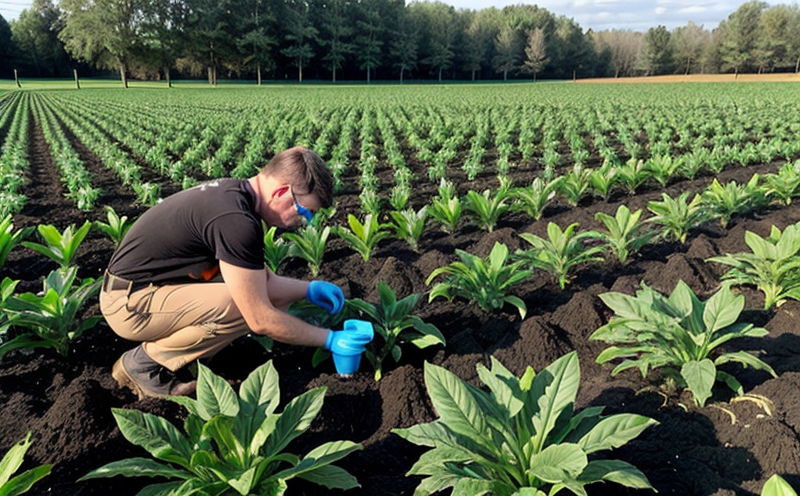Fertilizer Leaching Potential Testing
Fertilizer leaching potential testing is a critical procedure within the agriculture and forestry sectors that ensures optimal nutrient delivery to crops. This test evaluates how quickly and in what quantities fertilizers can be washed away from soil due to irrigation, rainfall, or other water-related activities. Accurate measurement of this phenomenon helps prevent overuse of fertilizers, thereby reducing environmental pollution and enhancing soil health.
The testing process involves several steps, starting with the collection of soil samples from various locations within a field or plantation. These samples are then mixed in specific ratios to simulate real-world conditions under which fertilizers may be applied. After mixing, the sample is placed into a controlled environment that mimics natural rainfall and irrigation patterns.
During this process, it's essential to monitor not just the quantity of water passing through the soil but also its temperature, pH level, and other relevant parameters. This detailed monitoring allows us to determine exactly how much nutrient material is being carried away by leaching. The results provide valuable insights into both the efficiency of fertilizer application methods and potential environmental impacts.
Using advanced laboratory equipment such as conductivity meters, spectrophotometers, and ion chromatographs, our team meticulously analyzes each sample post-leach to quantify the nutrient content present in the runoff water. This data helps farmers make informed decisions about adjusting their fertilization practices accordingly.
The importance of this service cannot be overstated given current global challenges like climate change and increasing demand for food production without harming natural resources. By providing accurate measurements of fertilizer leaching potential, we contribute significantly towards sustainable agricultural practices that preserve soil fertility and protect water bodies from contamination.
- Conductivity Meters: Measure the total dissolved solids in the leachate to assess nutrient content.
- Spectrophotometers: Analyze specific ions like nitrogen or phosphorus within the leachate for precise quantification.
- Ion Chromatographs: Separate and identify various organic compounds present in the leachate, including potential pollutants.
Why It Matters
Fertilizer leaching is a significant concern for both agricultural productivity and environmental sustainability. Excessive nutrient runoff can lead to eutrophication in nearby water bodies, causing algal blooms that deplete oxygen levels and harm aquatic life. Additionally, wasted fertilizer reduces overall crop yields over time by depleting essential nutrients from the soil.
Understanding the leaching potential helps farmers optimize their use of fertilizers, ensuring they apply just enough to meet plant needs while minimizing waste. This not only improves economic efficiency but also promotes healthier ecosystems and more resilient farming practices.
From a regulatory perspective, accurate measurements are crucial for compliance with environmental protection laws aimed at reducing agricultural pollution. By participating in such testing programs, farmers demonstrate their commitment to responsible land management and contribute positively to broader sustainability goals.
Applied Standards
Fertilizer leaching potential tests are governed by several international standards designed to ensure consistent methodology across different regions. For instance, ISO 14680 specifies procedures for determining the nutrient content of leachate from agricultural soils treated with chemical fertilizers.
ASTM D5739 provides guidelines on sampling and analysis techniques for assessing the impact of irrigation practices on soil properties, including those related to fertilizer leaching. Similarly, EN 14826 covers aspects specific to organic amendments in agriculture, which can influence nutrient retention capabilities and thus affect leaching rates.
These standards provide a framework within which laboratories like ours operate, ensuring that all tests are conducted according to best practices recognized worldwide. Compliance with these standards not only enhances credibility but also fosters trust among stakeholders involved in agricultural production processes.
Quality and Reliability Assurance
- Certified Personnel: Our team comprises experts certified by recognized bodies such as the American Society for Testing Materials (ASTM) and International Organization for Standardization (ISO).
- Laboratory Accreditation: Our facilities are accredited to ISO/IEC 17025, ensuring adherence to strict quality assurance protocols.
- Standard Operating Procedures: Every aspect of our testing process follows documented procedures validated through rigorous validation studies.
- Continuous Improvement: Regular audits and feedback loops ensure that our methods remain up-to-date with the latest scientific advancements and regulatory requirements.





